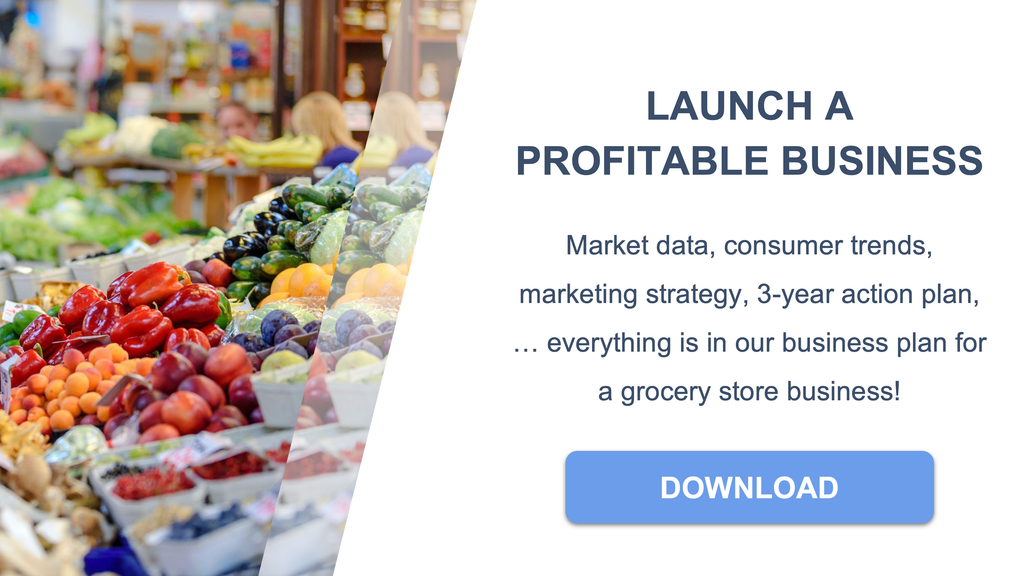This article was written by our expert who is surveying the industry and constantly updating the business plan for a grocery store.

Understanding grocery store monthly income is crucial for anyone considering entering this competitive retail sector.
Monthly income varies dramatically based on store size, location, and operational efficiency, with small stores generating $20,000-$30,000 while large supermarkets can reach $1-2.5 million monthly. Success in the grocery business requires precise cost management, optimal inventory turnover, and strategic location selection to achieve sustainable profitability margins.
If you want to dig deeper and learn more, you can download our business plan for a grocery store. Also, before launching, get all the profit, revenue, and cost breakdowns you need for complete clarity with our grocery store financial forecast.
Grocery store monthly income depends heavily on store size, location, and operational efficiency. Small stores typically generate $20,000-$30,000 monthly while large supermarkets can reach $1-2.5 million.
Net profit margins remain thin at 1.6-2.2%, requiring precise cost control and high inventory turnover to maintain profitability.
| Store Size | Monthly Revenue | Daily Customers | Average Basket | Net Profit Range |
|---|---|---|---|---|
| Small Store | $20,000-$30,000 | 65 customers | $10 | $1,000-$3,000 |
| Medium Store | $50,000-$100,000 | 160 customers | $10-$15 | $5,000-$10,000 |
| Large Supermarket | $1M-$2.5M | 1,520 customers | $25 | $30,000-$50,000 |
| High-Performing Small | $35,000-$45,000 | 80-100 customers | $12-$15 | $5,000-$8,000 |
| High-Performing Medium | $120,000-$180,000 | 200-250 customers | $18-$22 | $15,000-$25,000 |
| High-Performing Large | $3M-$4M | 2,000+ customers | $30-$35 | $100,000-$200,000 |
| Poorly Managed (Any Size) | 20-30% below average | 30-40% below average | 15-25% below average | -$2,000 to -$100,000 |

What is the average daily customer traffic and average basket size per customer in a typical grocery store?
Daily customer traffic and basket size vary significantly based on store size and location, with small grocery stores typically serving 65 customers daily while large supermarkets handle over 1,500 customers.
Small grocery stores average around 65 customers per day with a typical basket size of $10, generating approximately $650 in daily revenue. Medium-sized stores see about 160 customers daily, maintaining similar basket sizes of $10-15, which translates to roughly $1,600 in daily sales.
Large supermarkets operate at a much higher volume, serving approximately 1,520 customers per day with significantly larger basket sizes averaging $25. This combination results in daily revenues of around $38,000. Suburban locations often see higher basket sizes due to bulk purchasing patterns and family shopping trips.
Urban stores typically experience more frequent visits with smaller basket sizes, while suburban and rural locations see fewer but larger shopping trips. The average basket size across all grocery stores ranges from $25 to $174, depending on store format, location demographics, and shopping patterns.
What is the typical monthly revenue range of a small, medium, and large grocery store in USD, and how does this vary with location?
Monthly revenue ranges vary dramatically across grocery store sizes, with small stores generating $20,000-$30,000, medium stores earning $50,000-$100,000, and large supermarkets achieving $1-2.5 million monthly.
| Store Size | Monthly Revenue Range | Location Impact |
|---|---|---|
| Small Store (Rural) | $20,000-$30,000 | Urban areas can increase revenue by 20% due to higher population density and foot traffic |
| Medium Store (Suburban) | $50,000-$100,000 | Locations near high-density housing see 15% revenue increases from regular customer base |
| Large Supermarket (Urban) | $1M-$2.5M | Affluent neighborhoods boost revenue by 10% through higher-value purchases and premium products |
| Small Store (Urban) | $24,000-$36,000 | Higher foot traffic compensates for smaller individual basket sizes |
| Medium Store (Rural) | $42,000-$85,000 | Lower population density reduces customer base but increases basket sizes |
| Large Store (Suburban) | $1.2M-$2.8M | Family-oriented shopping patterns increase average transaction values |
| Tourist Areas (Any Size) | 25-40% seasonal variation | Revenue fluctuates significantly based on tourist seasons and local events |
What are the major categories of products sold, and what is the average gross margin percentage for each?
Grocery stores operate across multiple product categories with varying profit margins, with alcohol and specialty items offering the highest margins while basic staples like dairy and packaged goods provide lower but steady returns.
| Product Category | Gross Margin % | Key Characteristics |
|---|---|---|
| Fresh Produce | 38% | High margins offset by significant shrinkage (5-6%) and short shelf life requiring frequent restocking |
| Dairy Products | 25-30% | Stable demand with consistent customer traffic, shorter shelf life requires careful inventory management |
| Packaged Goods | 20-28% | Low waste with longer shelf life, competitive pricing pressure from national brands |
| Alcohol & Beverages | 50-60% | Highest margins especially for premium brands, regulated category with licensing requirements |
| Meat & Seafood | 30-35% | Higher margins for fresh cuts, requires specialized storage and handling equipment |
| Frozen Foods | 25-32% | Moderate margins with lower shrinkage, requires freezer equipment and energy costs |
| Health & Beauty | 40-50% | High margins on branded items, impulse purchase category with lower inventory turnover |
What are the primary recurring monthly costs and what is the usual cost breakdown in USD?
Monthly operating costs for grocery stores include rent, labor, utilities, inventory, and shrinkage, with costs scaling dramatically based on store size and location.
| Cost Category | Small Store | Medium Store | Large Store |
|---|---|---|---|
| Rent/Lease | $2,000-$5,000 | $10,000-$20,000 | $50,000-$100,000 |
| Labor Costs | $7,500-$12,500 | $20,000-$40,000 | $150,000-$300,000 |
| Utilities (Electric, Water, Gas) | $1,000-$2,000 | $3,000-$5,000 | $10,000-$15,000 |
| Inventory Costs | $12,000-$18,000 | $30,000-$60,000 | $600,000-$1,200,000 |
| Insurance | $300-$800 | $800-$1,500 | $2,000-$5,000 |
| Shrinkage/Theft (1-3% of sales) | $200-$900 | $500-$3,000 | $10,000-$75,000 |
| Equipment Maintenance | $200-$500 | $500-$1,200 | $2,000-$5,000 |
How much inventory does a grocery store typically carry, how often is it replenished, and what are average monthly inventory costs and turnover rate?
Grocery stores typically maintain inventory levels equivalent to 10-15 times their annual turnover rate, with daily replenishment for perishables and 2-4 times weekly for non-perishables.
A store with $30,000 monthly cost of goods sold typically carries $24,000-$36,000 in inventory at any given time. This represents the standard inventory-to-sales ratio that ensures adequate stock without excessive carrying costs.
Perishable items like fresh produce, dairy, and bread require daily deliveries to maintain freshness and minimize shrinkage. Non-perishable goods are typically restocked 2-4 times per week based on sales velocity and storage capacity.
Inventory turnover rates average 10-15 times per year for most grocery stores, with optimized operations achieving rates of 20 or higher. High-performing stores focus on just-in-time inventory management to reduce carrying costs while maintaining stock availability.
You'll find detailed market insights in our grocery store business plan, updated every quarter.
What are the average monthly labor costs, including management, cashiers, stockers, and cleaning staff, and what staffing levels are typical per store size?
Labor costs represent one of the largest operational expenses for grocery stores, ranging from $7,500-$12,500 monthly for small stores to $150,000-$300,000 for large supermarkets.
| Position | Small Store | Medium Store | Large Store |
|---|---|---|---|
| Cashiers | 2-3 employees | 4-6 employees | 10-15 employees |
| Stockers/Associates | 1-2 employees | 3-5 employees | 15-20 employees |
| Management | 1 manager | 2-3 managers | 5-10 managers |
| Deli/Bakery Staff | 0-1 employee | 1-2 employees | 5-8 employees |
| Cleaning/Maintenance | Part-time/contracted | 1-2 employees | 3-5 employees |
| Security | Usually none | Part-time/contracted | 2-4 employees |
| Total Monthly Cost | $7,500-$12,500 | $20,000-$40,000 | $150,000-$300,000 |
How much does rent vary depending on the city and store size, and what percentage of revenue does rent typically represent?
Rent costs vary dramatically based on location and store size, with urban locations commanding $50-$100 per square foot annually while suburban areas range from $20-$40 per square foot.
For a typical 4,000 square foot store, urban rent ranges from $16,000-$33,000 monthly while suburban locations cost $6,600-$13,000 monthly. These figures can vary significantly based on local market conditions and specific neighborhood demographics.
Rural areas generally offer the lowest rent costs, often 30-50% below suburban rates, but may have limited customer bases. Prime urban locations near transportation hubs or in high-traffic areas command premium rents but offer greater revenue potential.
Rent typically represents 5-10% of total revenue for well-performing grocery stores. Stores paying more than 10% of revenue on rent often struggle with profitability unless they can command premium pricing or achieve exceptional sales volumes.
What are common additional costs like credit card fees, POS systems, cleaning services, software, licenses, and how much do they add up to monthly?
Additional operational costs include credit card processing fees, point-of-sale systems, cleaning services, software subscriptions, and various licenses that collectively add $1,000-$15,000 monthly depending on store size.
Credit card processing fees typically range from 2-3% of total sales, representing $400-$3,000 monthly for most stores. This cost has become unavoidable as cash transactions continue to decline across all demographics.
Point-of-sale systems cost $80-$300 monthly per terminal, with larger stores requiring multiple systems for checkout efficiency. Modern POS systems include inventory management, sales analytics, and customer relationship features.
Licenses and insurance costs range from $500-$2,000 monthly, covering business licenses, food handling permits, liability insurance, and workers' compensation. These costs are largely fixed regardless of sales performance.
This is one of the strategies explained in our grocery store business plan.
How much profit per month does a poorly managed grocery store make (or lose), and what are typical mistakes that hurt profitability?
Poorly managed grocery stores often operate at a loss, with small stores losing $2,000-$5,000 monthly, medium stores losing $10,000-$20,000, and large stores potentially losing $50,000-$100,000 monthly.
Common profitability mistakes include overstocking perishable items leading to excessive shrinkage, inadequate staff training resulting in poor customer service and theft, and inefficient store layout that reduces sales per square foot. These operational failures compound quickly in the thin-margin grocery business.
Poor inventory management represents the largest threat to profitability, with some stores experiencing shrinkage rates of 5-8% compared to the industry average of 1-3%. This occurs through overordering perishables, inadequate rotation practices, and insufficient theft prevention measures.
Inadequate pricing strategies also hurt profitability, with stores either pricing too high and losing customers to competitors or pricing too low and sacrificing necessary margins. Successful stores use dynamic pricing and competitive analysis to optimize margins while maintaining customer loyalty.
Inefficient labor scheduling leads to overstaffing during slow periods and understaffing during peak times, resulting in both higher costs and lost sales opportunities. Poor vendor relationships also increase costs and reduce product availability.
How much net profit per month does an average grocery store generate, and what are the typical practices that maintain this level?
Average grocery stores generate net profits of $1,000-$3,000 monthly for small stores, $5,000-$10,000 for medium stores, and $30,000-$50,000 for large supermarkets, representing industry-standard profit margins of 1.6-2.2%.
Successful stores maintain profitability through precise inventory management, ensuring optimal stock levels without excessive carrying costs. They implement first-in-first-out rotation practices to minimize shrinkage and maintain strong relationships with suppliers for better pricing and terms.
Effective labor management includes cross-training employees for multiple roles, scheduling based on historical traffic patterns, and maintaining appropriate staff-to-customer ratios during peak hours. These practices control labor costs while ensuring adequate customer service.
Average-performing stores focus on category management, optimizing product mix based on local demographics and sales data. They maintain competitive pricing through regular market analysis while identifying opportunities for higher-margin private label products.
Regular financial monitoring and cost control measures help maintain profitability, including weekly profit and loss reviews, monthly inventory reconciliation, and quarterly vendor negotiations to secure better terms and pricing.
What is the potential monthly net profit of a high-performing, well-managed grocery store with optimized sourcing, pricing, layout, and customer retention strategies?
High-performing grocery stores can achieve exceptional profitability with monthly net profits of $5,000-$8,000 for small stores, $15,000-$25,000 for medium stores, and $100,000-$200,000 for large supermarkets through operational excellence and strategic optimization.
These stores achieve higher profit margins through advanced inventory management systems that optimize ordering, reduce shrinkage to under 1%, and maximize inventory turnover rates to 20 or higher. They leverage data analytics for demand forecasting and automated reordering systems.
Strategic pricing optimization includes dynamic pricing based on competitor analysis, customer behavior data, and local market conditions. High-performers also develop strong private label programs that offer 30-50% higher margins than national brands while providing customer value.
Store layout optimization maximizes sales per square foot through strategic product placement, effective end-cap displays, and impulse purchase opportunities. These stores also implement customer loyalty programs that increase average basket size and shopping frequency.
Superior vendor relationships enable better pricing, exclusive products, and favorable payment terms. High-performing stores often achieve cost reductions of 5-10% through strategic partnerships and volume purchasing agreements.
We cover this exact topic in the grocery store business plan.
Are there seasonal trends that impact monthly revenue and profit, such as holidays, school season, weather, or tourism, and how can a store anticipate and adapt to them?
Seasonal trends significantly impact grocery store revenue, with holidays generating 20-30% revenue spikes during Thanksgiving and Christmas, while summer months boost fresh produce sales and winter increases packaged goods demand.
Holiday seasons represent the most significant revenue opportunities, with November and December typically showing the highest monthly sales due to Thanksgiving, Christmas, and New Year celebrations. Stores must prepare with increased inventory, extended hours, and additional seasonal staff.
Summer weather patterns increase demand for fresh produce, beverages, and grilling supplies, while winter months see higher sales of comfort foods, hot beverages, and shelf-stable items. Back-to-school seasons boost sales of lunch items and snacks.
Tourist areas experience dramatic seasonal variations, with some stores seeing 40-60% revenue fluctuations between peak and off-seasons. These stores must carefully manage inventory and staffing to remain profitable during slower periods.
Successful stores anticipate seasonal trends through historical sales analysis, weather forecasting, and local event calendars. They adjust inventory mix, create seasonal displays, and develop targeted promotional campaigns to maximize revenue during peak periods while maintaining profitability year-round.
Conclusion
This article is for informational purposes only and should not be considered financial advice. Readers are encouraged to consult with a qualified professional before making any investment decisions. We accept no liability for any actions taken based on the information provided.
Understanding grocery store monthly income requires careful analysis of multiple revenue streams, cost structures, and operational factors that directly impact profitability in this competitive retail sector.
Success in the grocery business depends on achieving optimal balance between revenue generation through strategic pricing and inventory management while controlling costs through efficient operations and smart vendor relationships.
Sources
- Grocery TV - Grocery Foot Traffic Data Trends
- Drive Research - Grocery Store Statistics
- Dojo Business - Grocery Store Profitability
- Wave Grocery - Daily Grocery Store Revenue
- Gourmet Food Marketplace - Profit Margins by Category
- Fresh Produce - Retail Benchmark Data
- Toast POS - Supermarket Profitability
- Business Plan Templates - Grocery Store Running Costs
- Markt POS - Inventory Turnover Rates
- Statista - Shopping Center Real Estate Rents



